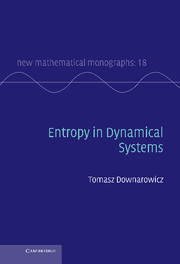Book contents
- Frontmatter
- Contents
- Preface
- Introduction
- PART I Entropy in ergodic theory
- PART II Entropy in topological dynamics
- 6 Topological entropy
- 7 Dynamics in dimension zero
- 8 The entropy structure
- 9 Symbolic extensions
- 10 A touch of smooth dynamics*
- PART III Entropy theory for operators
- Appendix A Toolbox
- Appendix B Conditional S–M–B
- List of symbols
- References
- Index
6 - Topological entropy
from PART II - Entropy in topological dynamics
Published online by Cambridge University Press: 07 October 2011
- Frontmatter
- Contents
- Preface
- Introduction
- PART I Entropy in ergodic theory
- PART II Entropy in topological dynamics
- 6 Topological entropy
- 7 Dynamics in dimension zero
- 8 The entropy structure
- 9 Symbolic extensions
- 10 A touch of smooth dynamics*
- PART III Entropy theory for operators
- Appendix A Toolbox
- Appendix B Conditional S–M–B
- List of symbols
- References
- Index
Summary
Three definitions of topological entropy
By a topological dynamical system we understand the triple (X, T, S), where X is a compact metric space, T : X → X is continuous and S ∈ {ℕ0,ℤ} is the semigroup acting on X via the iterates of T. Of course, ℤ is available only when T is a homeomorphism.
Just like in the measure-theoretic case, we are interested in a notion of entropy that captures the complexity of the dynamics, interpreted as the amount of information transmitted by the system per unit of time. Again, the initial state carries complete information about the evolution (forward, or both forward and backward in time, depending on the acting semigroup S), but the observer cannot “read” all this information immediately. Since we do not fix any particular measure, we want to use the metric (or, more generally, the topology) to describe the “amount of information” about the initial state, acquired by the observer in one step (one measurement). A reasonable interpretation relies on the notion of topological resolution. Intuitively, resolution is a parameter measuring the ability of the observer to distinguish between points. A resolution is topological, when this ability agrees with the topological structure of the space. The simplest such resolution is based on the metric and a positive number ε: two points are “indistinguishable” if they are less than ε apart. Another way to define a topological resolution (applicable in all topological spaces) refers to an open cover of X.
- Type
- Chapter
- Information
- Entropy in Dynamical Systems , pp. 159 - 200Publisher: Cambridge University PressPrint publication year: 2011



